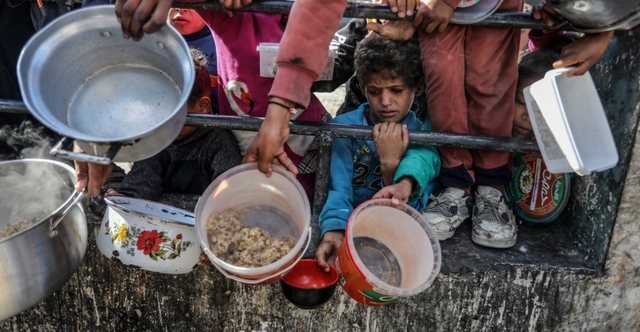
International aid cuts, UN report: Child mortality rate risks rising

A report published by the United Nations warns that cuts to international aid could lead to the deaths of many children, at a time when mortality among those under 5 has decreased in recent years.
The annual report, which is compiled by UNICEF, the World Health Organization (WHO) and the World Bank, does not specifically mention the United States. However, it comes weeks after the Trump administration announced it was cutting off most of the US Agency for International Development (USAID) programs, which had an annual budget of $42.8 billion.
"The global health community has never been more concerned," Fuzia Shafiq, a UNICEF official who deals with health issues, told Agence France-Presse.
In 2023, under-five mortality continued to decline, with 4.8 million deaths, including 2.3 million newborn babies who were less than one month old, according to the report.
Having fallen below 5 million for the first time in 2022, this new historic figure marks a 52% decline since 2000. Also, since 2015, progress has begun to slow, a trend that has been exacerbated by the diversion of funds for several years to address the COVID-19 pandemic.
“Without the right policy choices and sufficient investment, we risk seeing a reversal of hard-won progress,” warned UNICEF Executive Director Catherine Russell. “We cannot allow this to happen,” she added.
The consequences of funding cuts, the report warns, will be most severe where mortality rates were already highest: in sub-Saharan Africa and South Asia.
"Simply put, if support for vital services is not continued, many countries can expect an explosion in infant and child deaths," the report says.
Some consequences have already begun to be felt: lack of medical personnel, closure of clinics, problems in vaccination programs, lack of medications, especially for treating the plague.
One example is Ethiopia, where malaria is still a major problem. Fuzia Shafiq from UNICEF explained that the country faces a lack of diagnostic tests, no insecticide-treated mosquito nets, and no resources for mosquito eradication campaigns.
Another report by the same institutions expresses concern about the mortality rate of stillbirths, which will reach 1.9 million by 2023. “Every day, more than 5,000 women experience the sad experience of giving birth to a stillborn child,” the report says.
With medical care and treatment during pregnancy, many of these deaths can be prevented, as can babies who are born prematurely and are very weak.
Deaths of young children can be reduced more broadly by combating treatable diseases, such as pneumonia and diarrhea.
"From fighting the plague to preventing stillbirths, to providing care for the youngest children, we can make a difference for millions of families," assured WHO Director-General Tedros Adhanom Ghebreyesus.
Latest news


How did LaCivita change the DP campaign? Berisha: He studied the opponent
2025-05-08 22:49:51

David defeats Goliath
2025-05-08 22:15:50

Journalist: There are SPAK infiltrators in party headquarters
2025-05-08 21:55:15
Who is the new Pope?
2025-05-08 21:48:13
Berisha finally reveals when he will retire from politics
2025-05-08 21:33:46


LaCivita in Lezha: Albanians will fire Edi Rama from his job
2025-05-08 21:11:20


Berisha: LaCivita chose us because he believes in Reagan's program
2025-05-08 20:48:40
He rejected America to serve Pogradec, Genti Çela tells about life in "Elevate"
2025-05-08 20:26:28




Pope Leo XIV greets the faithful for the first time in St. Peter's Square
2025-05-08 19:29:33




Photo session with LaCivitta in Tirana: For Great Albania
2025-05-08 18:40:18
Source: DASH decision a personal victory for Berisha
2025-05-08 18:30:10
Take off those crazy glasses and see where you've taken him?
2025-05-08 18:02:47
LDK files criminal charges against members of the incumbent Government
2025-05-08 18:02:00







BIRN analysis: Tirana, the determining district for the future majority
2025-05-08 16:04:03




Chris LaCivita's contract with the DP, Berisha: 100% correct and clean
2025-05-08 15:11:11

"These are the peak days", Berisha reveals when he will travel to the USA
2025-05-08 14:45:25


Endless boxes with filled-in ballots, DP demands separation of votes from Greece
2025-05-08 14:11:12


Photo/ Who are the 3 associates of Talo Çela arrested in Dubai?
2025-05-08 13:37:09

Hetimi për krimet zgjedhore, Altin Dumani zbarkon në Prokurorinë e Shkodrës
2025-05-08 13:06:21
DASH paves the way for Berisha, Alizoti: Great news on the eve of Great Albania!
2025-05-08 13:03:48

"Freedom works", DP welcomes the US position
2025-05-08 12:48:07

Black smoke rises from the Sistine Chapel, the Vatican still without a Pope
2025-05-08 12:26:18





Davide Pecorrelli extradited to Albania
2025-05-08 11:29:04
'May 11, Albania will react', Xhaferri: Electoral criminals will pay
2025-05-08 11:21:46

Gjin Gjoni: Non Grata fell, Rama should get ready to go to McGonigal
2025-05-08 11:01:54
May 8th deadline for immigrants to vote in Greece extended by one day
2025-05-08 10:48:42
Collapse of massive chrome structure, still no trace of 29-year-old
2025-05-08 10:40:04
Vehicle bursts into flames in Paris Commune
2025-05-08 10:25:43
He gave land to his father and cousin, Basir Çollaku denounces the SP candidate
2025-05-08 10:16:16




Electoral Crimes/ BKH agents and Police conduct checks in Shkodra
2025-05-08 09:19:13
3 associates of Talo Çela arrested in Dubai
2025-05-08 09:02:28
Mouse in the owl's claws, Chris LaCivita responds directly to Rama
2025-05-08 08:45:40
Foreign exchange, how much foreign currencies are sold and bought today
2025-05-08 08:30:38
BIRN: Organized crime, the 'invisible party' of the Durrës elections
2025-05-08 08:26:35
Horoscope, what do the stars have in store for you today?
2025-05-08 08:08:15
Cloudy and rainy, what the weather is expected to be like throughout the day
2025-05-08 07:52:13
Posta e mëngjesit/ Me 2 rreshta: Çfarë pati rëndësi dje në Shqipëri
2025-05-08 07:40:16


Rama attacks Bardhi: Fier cannot be represented by the world's gas
2025-05-07 22:36:22



EU calls on Israel to lift humanitarian blockade in Gaza
2025-05-07 21:42:34
"Russia is "asking for a lot"! Vance calls for direct Moscow-Kiev talks
2025-05-07 21:20:16





Bank of Albania sets limits on home loans, Sejko: The maximum will be 85%
2025-05-07 20:16:10


EP calls for immediate lifting of measures against Kosovo
2025-05-07 19:39:58

